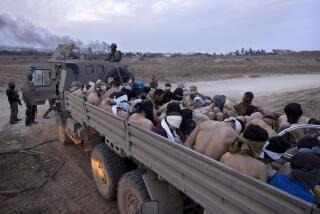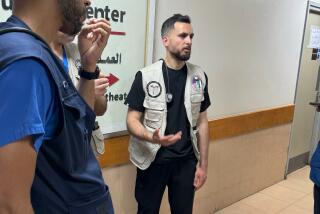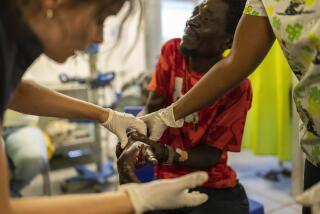Chaos Reigned in Dark New Orleans Hospital
NEW ORLEANS — The day before the hurricane struck, Dr. Anna Maria Pou stopped by her 83-year-old widowed mother’s house on Fountainbleau Street and urged her to get out of town as soon as possible.
“She came here to tell me to get going,” Jeanette Pou recalled. “She said she was going to be at the hospital, so don’t worry. She said, ‘I’ll be in touch.’
“But we didn’t get in touch with her.... She didn’t call.”
Not everyone agrees on the details of Pou’s subsequent troubles as she and hundreds of others were trapped at Memorial Medical Center in the days after Hurricane Katrina. But one fact is clear: Pou -- along with two nurses, Lori L. Budo and Cheri A. Landry -- was arrested this week on suspicion of killing four patients in the Uptown hospital with a lethal combination of drugs. An affidavit filed by Louisiana investigators states that Pou, 50, told co-workers that the patients -- all staying in a seventh-floor long-term care facility -- “were probably not going to survive.”
The doctor, through her attorney, has declined to tell her side of the story, but her friends, family and colleagues have rushed to her defense. She is an impeccable doctor, they say -- the kind who publishes research and wins awards, but also readily shares her cellphone number with patients.
She was a Catholic schoolgirl, New Orleans born, who joined the profession even though her physician father warned against the grueling hours. She went on to specialize in head and neck surgery, reconstructing faces eaten away by cancer.
Jeanette Pou says her daughter was motivated by an acute sense of compassion: Of 11 brothers and sisters, she took the greatest pleasure looking after the family pets. When she went to medical school, her mother said, Pou couldn’t bring herself to kill a guinea pig as part of her laboratory training.
A year before the storm, she had returned to New Orleans from Texas, taking a pay cut to be closer to her aging mother.
These conflicting portraits of the doctor -- on one hand, exceedingly empathetic; on the other, callous to the point of criminality -- are difficult to reconcile for many in New Orleans, a city struggling in many other cases to reconstruct the events that followed Katrina, and determine its heroes and villains.
The facts that have emerged do not answer those kinds of questions about the doctor. What is clear is that at the time of the alleged killings, she was helping lead a hospital staff that was in the throes of confusion and despair.
They also reveal a bitter irony: Her alleged crimes occurred on a day when the evacuation effort had finally started to step up. By the end of that day, all of the hospital’s sickest patients would be rescued.
*
Just before Hurricane Katrina bore down on the city, Pou called her boss, Dr. Daniel Nuss, chairman of the otolaryngology department at Louisiana State University Health Sciences Center. He had evacuated to Houston; she was at Memorial.
The storm was likely to make landfall while Pou was scheduled to work at Memorial as part of a rotation of ear, nose and throat specialists, so she was obliged to ride out the storm there.
Nuss said Pou’s phone call was typical for her -- calm and professional.
“She was focused on ... making all the right preparations to dig in,” he said. “Not prone to any kind of panic.”
Memorial, which is owned by Tenet Healthcare Corp., had weathered many storms in its eight decades as one of New Orleans’ most important hospitals. Founded in 1926 as Southern Baptist Hospital, it was centrally located, offered a wide range of health services, and had long served a diverse clientele -- rich and poor, black and white.
Its main building was sturdy, brick and eight stories high. Two days before Katrina, 19 patients were transferred there from a one-story medical facility in low-lying Chalmette.
They were placed on the seventh floor, where a company called LifeCare Holdings Inc. ran a “long-term acute care” facility. It operated independently of Memorial, and its patients were typically those with serious complications: people on ventilators, people who were paralyzed, people who in some cases were close to death. With the transfer, there were 55 patients just before the storm.
Also swelling the building’s ranks were the staffers’ family members, who took refuge in the hospital. All told, there were about 2,000 people hunkered down and awaiting the storm.
When the storm skirted New Orleans on Monday, Aug. 29, the staff at Memorial, like many residents across the city, thought they had survived the worst. Some patients and staffers went home.
“Nurses worked as if it was a regular Monday,” recalled Dr. John Kokemor, 54, an internist who was on duty at the hospital after Katrina.
The cooks prepared a hot evening meal, and the people formed a chow line.
They were unaware that the levees surrounding the city had failed. New Orleans was beginning to drown.
By Tuesday morning, the water had begun to rise in the neighborhood, and worry set in.
Pou, like a number of other doctors, immersed herself in the dozens of decisions they were facing, according to a Tenet manager who declined to be named because the company had not authorized the comments.
“She was always there and always just working, just a little sprite of a person ... a little pistol,” the manager said of Pou, who stands just over 5 feet. “Every time you saw her, she was directing. Physically she was the smallest [doctor], but she had a huge presence.”
The challenges were daunting. The water rose to 12 feet, flooding the basement and ruining the pumps that powered the rooftop generators. They worked intermittently through Tuesday. But by Wednesday morning, the hospital was dark.
Electronically powered medical equipment, such as IV drips, began to seize up. Nurses had to manually regulate patients’ medication. Some patients went from bad to worse.
The hospital’s land-line phones stopped functioning Tuesday at 2 p.m. Cellphones died. Cloudy skies hampered satellite phones.
Sporadic help arrived. On Monday night, Coast Guard helicopters took away 18 babies who had been in intensive care. National Guard trucks also hauled away dialysis patients before the water got too high.
From their limited contact with the hospital, employees at Tenet’s Dallas headquarters knew that Memorial needed more help. They called local and state officials throughout Tuesday but were eventually told that if they wanted to speed the evacuation, they would have to hire their own fleet of helicopters, said Harry Anderson, a Tenet spokesman.
Inside the hospital, the temperature soared above 100 degrees. Staffers used oxygen carts to smash windows in an effort to provide ventilation. Nearby residents waded through floodwaters seeking dry turf. Gunfire could be heard in the distance.
The toilets backed up and started to overflow. And people were dying.
When a patient is close to death in a hospital, caregivers issue a “code blue,” which prompts a resuscitation team to attend to the patient. Pou -- who had declined an early chance to evacuate -- responded to many of those calls, Nuss said.
During Wednesday morning’s crisis management meeting, doctors were told to begin a triage process, said Kokemor, the internist. Decisions had to be made about which patients might be able to wade through water to get to higher ground, which of them would need evacuating to nursing homes, and who among the patients was critical and needed to be transferred to another acute-care facility.
While the doctors waited for helicopters to arrive, volunteers arrived on airboats and were able to help ferry some patients to safety.
“There was no sign of any organized rescue effort, just these people who came from out of nowhere,” recalled Landry Rene Goux, the hospital’s then-CEO, in a first-person account published on its website.
By Wednesday afternoon, Tenet had six private helicopters on the scene, said Anderson, the Tenet spokesman. There was a sense of relief. But the evacuations were slow going.
The sickest patients were wrapped in sheets and carried in them, often down multiple flights of steps. From there, they were passed through a hole in the wall of a boiler room to a truck that drove them to the helipad atop the adjacent parking garage.
By Wednesday night, 160 “bedridden, very sick patients,” remained at the hospital, out of the initial patient tally of 260, according to Goux.
Early Thursday, the staff held another meeting and learned what Tenet officials in Dallas had discovered the day before: Major help from government entities would not be arriving soon.
The private helicopters had stopped making their runs the previous evening for reasons that are unclear, although Tenet officials said the evacuations were interrupted due to reports of gunfire.
Those helicopters would eventually return. But that morning, the news that no government rescue was imminent sent many staffers into “a state of shock,” Kokemor said. The relief of the previous day turned to panic.
That morning, Pou had begun taking charge on the seventh floor, according to the affidavit investigators filed to justify her arrest. The document also provided the following version of events, while omitting many names:
Conditions in the LifeCare facility had “deteriorated,” according to one nurse there -- although it is unclear exactly what that means. Nine critical patients remained on the floor.
At 7 a.m., LifeCare’s physical medicine director attended a meeting where Susan Mulderick, Memorial’s incident commander, said that she knew LifeCare patients were very sick.
“[W]e don’t expect them to make it,” Mulderick said.
Two hours later, the physical medicine director asked Mulderick what Memorial planned to do about evacuating LifeCare patients. Mulderick said they “were not going to leave any living patients behind.”
Then she told the director to go find Pou.
The physical medicine director encountered Pou and two nurses later in the LifeCare charting room. They were drawing something from vials into syringes. The director walked with the trio down the hall and showed them where the patients’ rooms were. Pou seemed nervous.
The director saw Pou walk into the room of an alleged victim identified as “E.E.,” age 61. Pou said she was going to tell him that she was going to give him something for his dizziness. Then she closed the door.
The director saw one of the nurses, Lori Budo, inject another alleged victim, a 90-year-old identified as “R.S.”
“That burns,” the director recalled hearing the patient say.
Pou told LifeCare’s pharmacy director that “a decision had been made to administer lethal doses to the LifeCare patients remaining on the seventh floor.” Pou showed the pharmacy director more than 25 vials of morphine that she intended to use.
At one point, another LifeCare worker, an administrator, encountered Pou sitting in a seventh-floor office. Pou said the patients were not going to survive and were unaware of what was happening. The administrator objected, pointing out that the patient “E.E.” was “aware, conscious and alert,” even though he was 380 pounds and paralyzed.
But Pou had decided he could not be evacuated.
Pou asked the administrators if a LifeCare staff member would sedate the large man. The administrator refused to let her staff get involved.
The two nurses entered the room as the LifeCare administrator was leaving the room. Pou told the administrator that “they didn’t have a lot of time, and that she needed to clear the floors as soon as she could.”
The pharmacy director recalled seeing Pou and the nurses walking in and out of the LifeCare patients’ rooms.
The administrator eventually went to round up her staff to take them down to the lower floors.
“I want y’all to know I take full responsibility,” Pou later told the administrator. “And y’all did a great job taking care of the patients.”
Some other LifeCare patients had been moved to the lower floors and were awaiting evacuation. But when the LifeCare staff members went to check on them, they were turned away by Memorial employees.
Throughout the day, the rescue efforts intensified. By Thursday evening, all of the patients in the hospital had been evacuated, according to Anderson, the Tenet spokesman. The rest of the people were gone by Friday. The hospital has not reopened.
Forty-five bodies were recovered from the hospital. Anderson said 11 died of natural causes before the storm. The rest, including 24 LifeCare patients, had died in the aftermath.
Louisiana Atty. Gen. Charles Foti has said that more arrests could come, and more alleged victims could be identified. Pou’s attorney, Richard Simmons, insists that his client is innocent. So do lawyers for the other two accused, whom Nuss described as skilled surgical intensive care unit nurses with 20 years of hospital experience between them.
*
When Pou was finally evacuated from New Orleans, she found her way to her mother, who had relocated to Baton Rouge.
Jeanette Pou remembers that her daughter was a mess. She had a black eye, although it wasn’t clear how she’d earned it.
“She was shaking, and she was crying,” her mother said. “She said they had 8 feet of water outside the hospital, that they were firing guns ... and they were all alone.”
Times researcher John Beckham contributed to this report.
More to Read
Sign up for Essential California
The most important California stories and recommendations in your inbox every morning.
You may occasionally receive promotional content from the Los Angeles Times.











